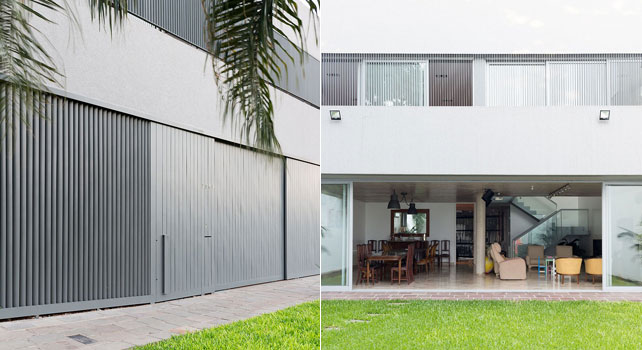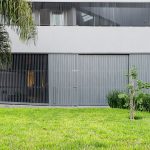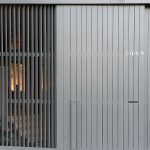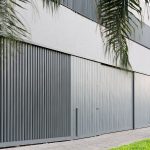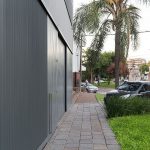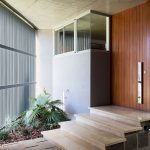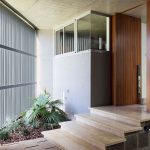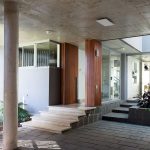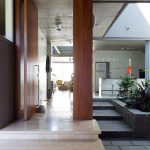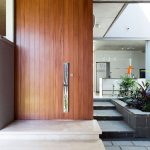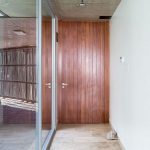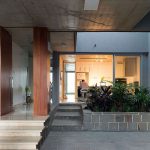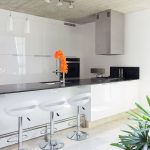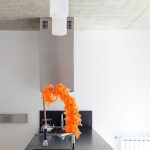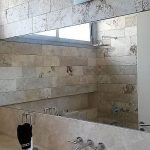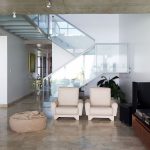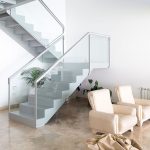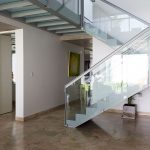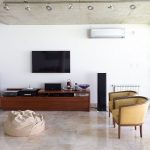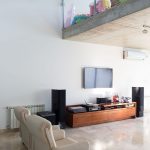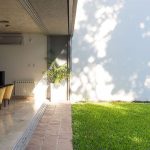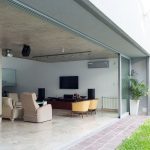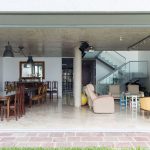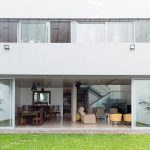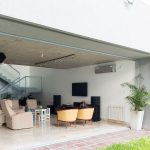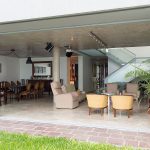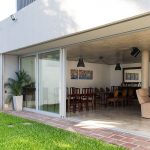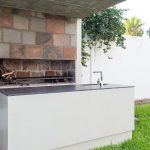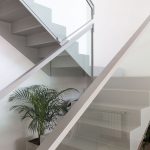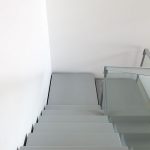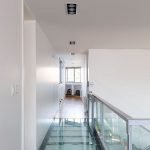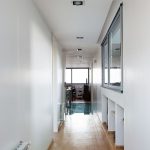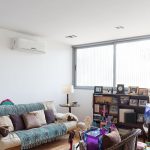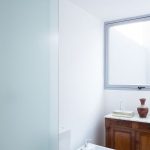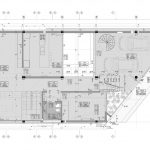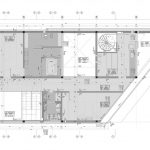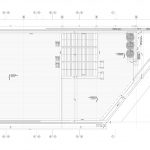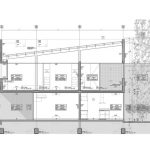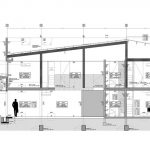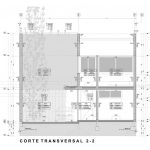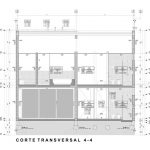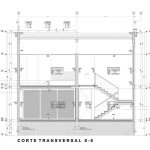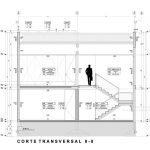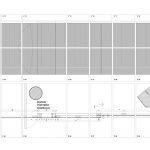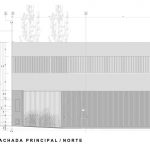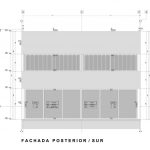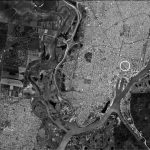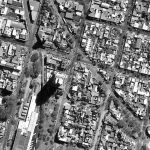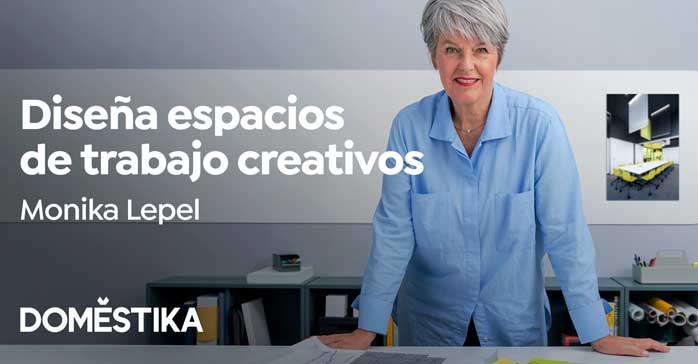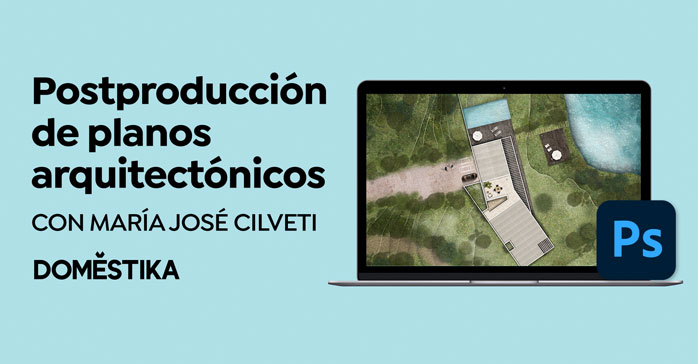Casa CCA (Santa Fe, Pcia. de Santa Fe, Argentina) por RCC Arquitectos. Una pareja de jóvenes profesionales decide encarar el proyecto de su casa. El lugar, un lote irregular entre medianeras en pleno Barrio Candioti, con la particularidad de encontrarse sobre una calle en diagonal, característica que condicionaría gran parte del proyecto. Una activa vida social y familiar, orientaría las principales intenciones del planteo.
El lote con frente al Norte tiene las dimensiones típicas de la zona, 10,00 metros de frente y 30,00 metros en su lateral más corto orientado al Este. Se trata de un área ya consolidada principalmente de viviendas unifamiliares. La necesidad de desarrollar un amplio programa de necesidades, guardacoches doble, estar comedor, cocina, lavadero, tres baños y 4 dormitorios, orienta a que la propuesta se desarrolle en dos niveles.
Se planteo generar un volumen prismático de apariencia compacta, buscando liberar el fondo del lote el cual sería la expansión abierta de la casa. Una sustracción en la zona central del volumen generando un patio interior proporcionaría vistas, iluminación y ventilación cruzada a locales principales.
Dada la amplia calle y vereda del lote, el planteo se compacta hacia el frente aprovechando el área irregular del mismo, volcando los locales secundarios. De esta manera, el frente de la casa de materializaría coincidente con la línea de edificación diagonal.
Se accede a la vivienda a través de una explanada vehicular o de veredas laterales. Una fachada apenas permeable delimita lo público de lo privado. Dos accesos, por un lado la puerta pivotante principal orienta el ingreso a la vivienda. Por otro lado doble acceso vehicular mediante portones corredizos que no demandan espacio al abrirse. A través de ambos ingresos se accede a un área semicubierta que hace de transición entre el exterior y el interior.
El acceso principal es a través de una recepción que articula varios locales, como ser el dormitorio/escritorio, el baño, el estar comedor y la circulación vertical. Otro acceso a la vivienda es a partir de la cochera, atravesando un patio interior y accediendo a la cocina.
El estar comedor se vincula con el jardín a través de su apertura total y a través del uso de puertas ventanas de piso a techo corredizas. Esto mismo sucede con la cocina hacia el patio interior.
La circulación vertical se jerarquiza mediante una escalera de chapa plegada y vidrio que llega a una pasarela de vidrio que balconea a la doble altura del estar.
En la planta alta se distribuye el dormitorio en suite orientando al Sur, un dormitorio o espacio multiuso continuo a este y también orientado al Sur y con balconeo sobre el Estar. En el otro extremo hacia el Norte se organiza un dormitorio, lavadero y tendedero.
Se planteo estructura independiente de hormigón armado, con losas y vigas chatas invertidas, ejecutadas mediante encofrado fenólico terminación melanina, proporcionando así la terminación final del cielorraso sobre planta baja. Sobre la planta alta se plantea una cubierta liviana de chapa ventilada, y cielorraso colgado de yeso plano.
Ficha técnica
Nombre Obra: Casa CCA
Ubicación: Santa Fe, Pcia. de Santa Fe, Argentina
Arquitectos: RCC Arquitectos
Arquitectos a cargo: Arq. Ramiro Carlos Cristina
Otros participantes, colaboradores: Nicolás Sambrana, Laura Alvarez Carrelo
Proyecto: 2010 – 2011
Ejecución: 2013 – 2016
Superficie construida: Cubierta: 292,45 m2, Semi-Cubierta: 80,67 m2
Fotógrafo: Arq. Ramiro Carlos Cristina
Contacto: http://www.rccarquitectos.com
English version
A couple of young professionals decide to face the project of their home. The place, an irregular lot between dividing wall in neighborhood Candioti, with the peculiarity of being on a street in diagonal, characteristic that would condition much of the project. An active social and family life, would guide the main intentions of the idea.
The lot facing the North has the typical dimensions of the area, 10.00 meters in front and 30.00 meters in its shorter side facing east. It is an area already consolidated mainly of detached houses. The need to develop an extensive program of necessities, double parking, be dining room, kitchen, laundry, three bathrooms, and 4 bedrooms, orients the proposal to develop in two levels.
It was proposed to generate a prismatic volume of compact appearance, seeking to release the bottom of the lot which would be the open expansion of the house. A subtraction in the central area of the volume generating an interior patio would provide views, lighting and cross ventilation to main premises.
Given the wide street and sidewalk of the lot, the approach is compacted towards the front taking advantage of the irregular area of the same, overturning the secondary premises. In this way, the front of the house would materialize coincident with the building line diagonal.
The house is accessed through a vehicular esplanade or sidewalks. A barely permeable façade delimits the public from the private. Two entrances, on the one hand the main pivoting door orients the entrance to the house. On the other hand double access vehicular by sliding doors that do not demand space when opening. Through both income is accessed a semi-covered area that transforms between the exterior and the interior.
The main access is through a reception desk that articulates several premises, such as Bedroom / Desk, Bathroom, Dining Room and Vertical Circulation. Another access to the house is from the garage, crossing an interior patio and accessing the kitchen.
The Dining Room is linked to the Garden through its total opening and through the use of sliding floor to ceiling windows. The same happens with the Kitchen towards the Interior Patio.
The Vertical Circulation is hierarchical by means of a Staircase of folded sheet and glass that arrives at a footbridge of glass that balcony to the double height of the Living.
On the upper floor is distributed the bedroom in suite facing south, a bedroom or multipurpose space continuous to this and also oriented to the south and with balcony on the living. At the other end to the north is a bedroom, laundry and drying rack.
An independent reinforced concrete structure was proposed, with slabs and inverted flat beams, executed by means of phenolic formwork, finishing melanin, thus providing the final termination of the ceilings on the ground floor. On the top floor there is a light cover of ventilated sheet, and ceiling suspended from flat plaster.


